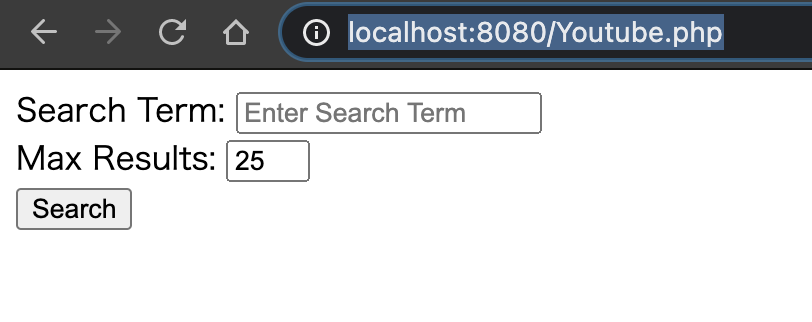はじめに
YoutubeのAPIを爆速で使いたいという方向けの記事です。
とりあえずPHPでYoutubeDataAPIv3を直ぐに使えるようにできます。
事前準備として下の記事を参考にAPIキーを取得しておいてください。
http://piyohiko.webcrow.jp/kids_tube/help/index.html
参考記事
Dockerのディレクトリ構成については下記のものを参考にしました。
https://tech-blog.rakus.co.jp/entry/20200908/docker
ファイル構成
├── docker-compose.yml
├── nginx
│ └── default.conf
├── php
│ ├── Dockerfile
│ └── php.ini
└── src
├── Youtube.php
├── index.php
treeコマンドについては下記の記事を参考に
https://qiita.com/tatema/items/8a1de3d3b87884cb0d21
docker-compose.yml
Dockerfileやdocker-compose.ymlについての各コマンドについての説明は
DockerでLaravel+MySQL+phpMyadminの環境構築
または
https://tech-blog.rakus.co.jp/entry/20200908/docker
を参考に
version: '3'
services:
nginx:
image: nginx:stable-alpine
ports:
- "8080:80"
volumes:
- ./src:/var/www/html
- ./nginx/default.conf:/etc/nginx/conf.d/default.conf
php:
build: ./php
volumes:
- ./src:/var/www/html%
default.conf
server {
listen 80;
root /var/www/html;
index index.php index.html;
access_log /var/log/nginx/access.log;
error_log /var/log/nginx/error.log;
location / {
try_files $uri $uri/ /index.php$is_args$args;
}
location ~ \.php$ {
fastcgi_pass php:9000;
fastcgi_index index.php;
fastcgi_param SCRIPT_FILENAME $document_root$fastcgi_script_name;
include fastcgi_params;
}
}
Dockerfile
docker-php-ext-install pdo_mysql
これは不要かと思いますが、いつも僕はDockerfileに入れているので任意でお願いします。
FROM php:fpm
COPY php.ini /usr/local/etc/php/
RUN apt-get update \
&& apt-get install -y \
git \
zip \
unzip \
vim \
libpng-dev \
libpq-dev \
&& docker-php-ext-install pdo_mysql
RUN cd /usr/bin && curl -s http://getcomposer.org/installer | php && ln -s /usr/bin/composer.phar /usr/bin/composer
RUN cd && composer require google/apiclient:~2.0
php.ini
[Date]
date.timezone = "Asia/Tokyo"
[mbstring]
mbstring.internal_encoding = "UTF-8"
mbstring.language = "Japanese"
index.php
これはつくらなくてもつくってもOK
<?php
echo "Hello World!";
phpinfo();
Youtube.php
https://developers.google.com/youtube/v3/code_samples/php?hl=ja
YoutubeDataAPIの公式リファレンスからサンプルコードを引用した
<?php
/**
* Library Requirements
*
* 1. Install composer (https://getcomposer.org)
* 2. On the command line, change to this directory (api-samples/php)
* 3. Require the google/apiclient library
* $ composer require google/apiclient:~2.0
*/
if (!file_exists(__DIR__ . '/vendor/autoload.php')) {
throw new \Exception('please run "composer require google/apiclient:~2.0" in "' . __DIR__ .'"');
}
require_once __DIR__ . '/vendor/autoload.php';
$htmlBody = <<<END
<form method="GET">
<div>
Search Term: <input type="search" id="q" name="q" placeholder="Enter Search Term">
</div>
<div>
Max Results: <input type="number" id="maxResults" name="maxResults" min="1" max="50" step="1" value="25">
</div>
<input type="submit" value="Search">
</form>
END;
// This code will execute if the user entered a search query in the form
// and submitted the form. Otherwise, the page displays the form above.
if (isset($_GET['q']) && isset($_GET['maxResults'])) {
/*
* Set $DEVELOPER_KEY to the "API key" value from the "Access" tab of the
* Google API Console <https://console.developers.google.com/>
* Please ensure that you have enabled the YouTube Data API for your project.
*/
$DEVELOPER_KEY = 'ここにGoogleのAPIキーを入れてください';
$client = new Google_Client();
$client->setDeveloperKey($DEVELOPER_KEY);
// Define an object that will be used to make all API requests.
$youtube = new Google_Service_YouTube($client);
$htmlBody = '';
try {
// Call the search.list method to retrieve results matching the specified
// query term.
$searchResponse = $youtube->search->listSearch('id,snippet', array(
'q' => $_GET['q'],
'maxResults' => $_GET['maxResults'],
));
$videos = '';
$channels = '';
$playlists = '';
// Add each result to the appropriate list, and then display the lists of
// matching videos, channels, and playlists.
foreach ($searchResponse['items'] as $searchResult) {
switch ($searchResult['id']['kind']) {
case 'youtube#video':
$videos .= sprintf('<li>%s (%s)</li>',
$searchResult['snippet']['title'], $searchResult['id']['videoId']);
break;
case 'youtube#channel':
$channels .= sprintf('<li>%s (%s)</li>',
$searchResult['snippet']['title'], $searchResult['id']['channelId']);
break;
case 'youtube#playlist':
$playlists .= sprintf('<li>%s (%s)</li>',
$searchResult['snippet']['title'], $searchResult['id']['playlistId']);
break;
}
}
$htmlBody .= <<<END
<h3>Videos</h3>
<ul>$videos</ul>
<h3>Channels</h3>
<ul>$channels</ul>
<h3>Playlists</h3>
<ul>$playlists</ul>
END;
} catch (Google_Service_Exception $e) {
$htmlBody .= sprintf('<p>A service error occurred: <code>%s</code></p>',
htmlspecialchars($e->getMessage()));
} catch (Google_Exception $e) {
$htmlBody .= sprintf('<p>An client error occurred: <code>%s</code></p>',
htmlspecialchars($e->getMessage()));
}
}
?>
<!doctype html>
<html>
<head>
<title>YouTube Search</title>
</head>
<body>
<?=$htmlBody?>
</body>
</html>
ここまでファイルを作成し、ディレクトリへの配置も終わったら、docker-compose.ymlがあるディレクトリで
[Mac]docker-compose build
[Mac]docker-compose up
を実行し、終了後
http://localhost:8080/Youtube.php
にアクセスし、

のようなフォームが出ていたらOK
これでYoutubeDataAPIv3が使えるようになった。
https://developers.google.com/youtube/v3/code_samples/php?hl=ja
にたくさんのサンプルコードがあるのでそれを参考にすると色々遊べそう!